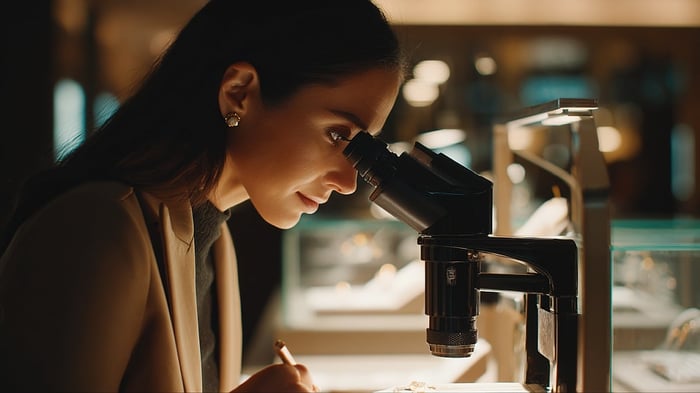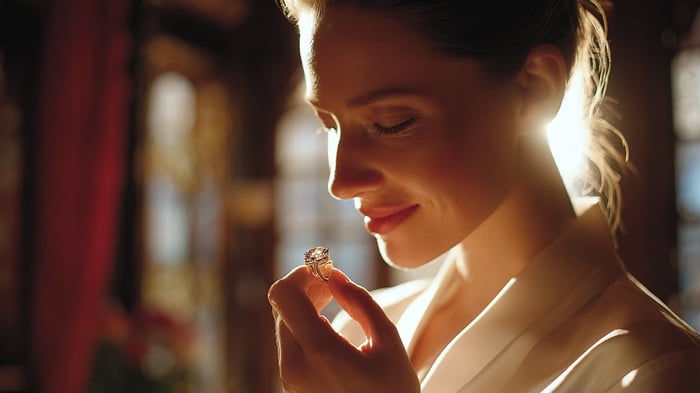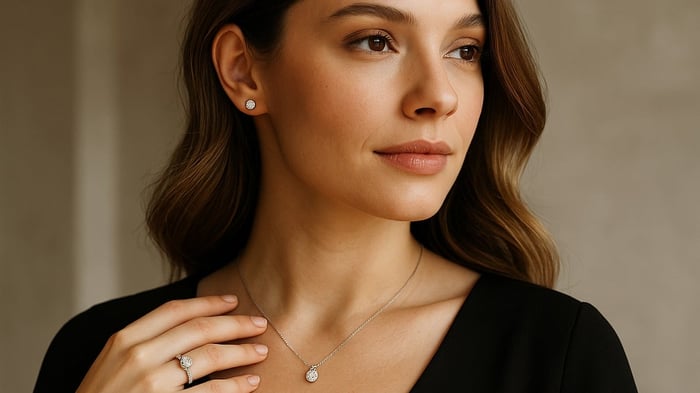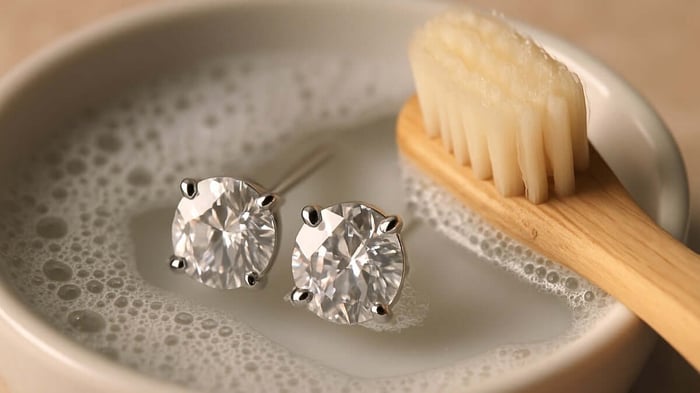Table of Contents
Real Talk on Diamond Quality:
Picture this: I once stared, utterly blank, at a jeweller brandishing a loupe at what looked no different to my eyes than cut glass. If you’ve ever wondered how on earth you’re supposed to tell if you’re looking at a diamond, let alone if it’s a ‘good’ one, you’re in the perfect place. Instead of baffling sales speak, let’s get down to the nitty-gritty of what really sets diamonds apart: GIA grades style—with a wink to the science and a nod to common sense.
TL;DR: You don’t need to be a gemologist to buy smart: understand the 4Cs, trust GIA grading for peace of mind, and always insist on a genuine report before making your diamond investment.
The Mysterious 4Cs: What’s Beneath the Sparkle?
When you look at a diamond, it’s easy to be dazzled by the sparkle. But what’s really going on beneath that glittering surface? To truly understand a diamond’s value and beauty, you need to get to grips with the 4Cs of Diamonds: colour, clarity, cut, and carat weight. As the Gemological Institute of America (GIA) puts it,
‘The key to understanding a diamond and its value is to understand the four attributes that all diamonds share, colour, clarity, cut, and carat weight, also known as the 4 Cs.’The GIA, founded in 1931, created the 4Cs as a universal language for diamond quality. Before this, there was no standard way to judge or compare diamonds—leading to confusion and inconsistency. Today, the GIA Diamond Grading System is the global benchmark, bringing objectivity and transparency to the world of diamonds.
The 4Cs of Diamonds: A Quick Overview
- Colour: How colourless (or not) a diamond is.
- Clarity: How free the diamond is from internal or surface flaws.
- Cut: How well the diamond has been shaped and faceted.
- Carat Weight: How much the diamond weighs.
Each of these attributes affects both how a diamond looks and how much it’s worth. Let’s dig into the two most mysterious Cs: colour and clarity.
Anillo con halo de diamantes y zafiros rosados ovalados de 1,88 ct en oro rosado de 18 k

€2.228,95
Este anillo notablemente femenino está hecho a mano en romántico oro rosado de 18k y presenta un hermoso zafiro rosado de talla ovalada montado en un engaste de cuatro garras. La piedra rosa de 1,52 quilates está rodeada por un… read more
Colour: More Than Just a Matter of Taste
When it comes to diamonds, less is more—at least when we’re talking about colour. The GIA Color Scale is the industry standard for grading diamond colour. It runs from D (completely colourless, and the most valuable) all the way to Z (which shows a noticeable hint of yellow or brown).
| Grade | Description |
|---|---|
| D-F | Colourless |
| G-J | Near Colourless |
| K-M | Faint Yellow |
| N-R | Very Light Yellow |
| S-Z | Light Yellow or Brown |
At the GIA lab, diamonds are graded for colour by comparing them to a master set of stones under controlled lighting. This isn’t about personal taste—it’s a scientific process. The closer a diamond is to a D grade, the rarer and more valuable it becomes. Even a subtle difference in colour can have a big impact on price, especially at the top end of the scale.
Clarity: The Diamond’s Unique Fingerprint
Next up is clarity. Every diamond is formed under intense heat and pressure, so it’s normal for them to have tiny internal features (called inclusions) or surface marks (called blemishes). The Diamond Clarity Grades set by GIA range from Flawless (no inclusions or blemishes visible under 10x magnification) to I3 (inclusions obvious to the naked eye).
| Grade | Description |
|---|---|
| FL | Flawless |
| IF | Internally Flawless |
| VVS1-VVS2 | Very, Very Slightly Included |
| VS1-VS2 | Very Slightly Included |
| SI1-SI2 | Slightly Included |
| I1-I3 | Included |
GIA graders use a 10x magnification loupe and a microscope to examine each diamond. They plot the inclusions and blemishes, creating a map that’s as unique as a fingerprint. A Flawless diamond is extremely rare and commands the highest prices. On the other end, an I3 diamond will have inclusions that are easy to spot without any tools.
Collar de cruz de diamantes con diamantes G/SI de 1,00 ct en oro amarillo de 18 quilates

€1.695,95
Este impresionante colgante de cruz de diamantes es una lujosa pieza de joyería. Un quilate de diamantes sostenibles y de calidad G/SI en un deslumbrante oro amarillo de 18k crea un hermoso brillo y fuego. Hecho a mano en el… read more
Why the 4Cs Matter
The 4Cs of Diamonds were designed to bring clarity (pun intended) and fairness to diamond buying. Each C changes how a diamond looks and how much it costs. The GIA Color Scale and Diamond Clarity Grades give you a way to compare stones side by side, so you know exactly what you’re getting—no guesswork, no surprises.
Understanding the 4Cs means you can look beyond the sparkle and make informed choices, whether you’re buying for beauty, value, or both.
Browse Our Natural Diamond Engagement Rings
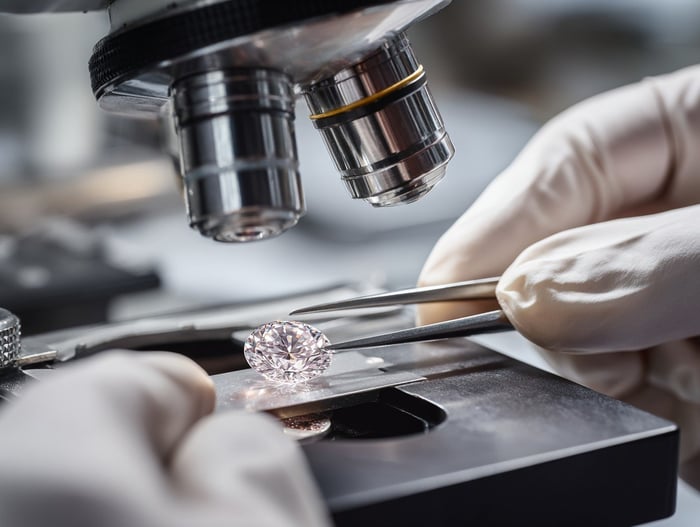
Science-Backed Bling: How Diamonds Are Actually Graded
When it comes to GIA Diamond Grading, you might imagine a jeweller peering through a magnifying glass and making a snap decision. In reality, the process is far more scientific and precise. The Gemological Institute of America (GIA), established in 1931, has set the gold standard for diamond grading, using strict protocols and cutting-edge technology to ensure every stone is evaluated objectively and consistently.
Objective Analysis: No Room for Bias
Every diamond that enters the GIA lab is treated with the utmost care to avoid any bias. Each stone travels through the facility in a nondescript case, so the gemologists have no clue about its origin or value. As the GIA puts it,
‘Scientific precision is critical as expert gemologists examine each diamond under tightly controlled lighting and viewing conditions.’This means every diamond is assessed under identical lighting, with advanced magnification tools, and in a controlled environment, ensuring your diamond’s grade is based on facts, not opinions.
Anillo de compromiso con solitario de diamante certificado de 0,70 ct de calidad E/VS en platino

€2.991,95
Ilumine los ojos de esa persona especial con una propuesta entregada con este hermoso anillo solitario de diamantes en un espectacular platino hecho a mano. Comiencen el próximo capítulo de sus vidas juntos con estilo, su amor reflejado en la… read more
Natural vs Lab-Grown Diamonds: The First Check
Before any grading begins, the GIA lab checks whether your diamond is natural or synthetic. This Natural vs Lab-Grown Diamonds verification is crucial. Using advanced spectroscopy and imaging, gemologists determine the stone’s origin. If a diamond is found to be lab-grown or synthetic, it’s immediately separated and sent through a different grading process. Only natural diamonds proceed through the standard GIA grading pipeline, ensuring clarity and transparency in the results.
The 4Cs: The Heart of GIA Diamond Grading
Once a diamond is confirmed as natural, it’s ready for the famous 4Cs assessment: Cut, Colour, Clarity, and Carat Weight. Each step is handled with scientific rigour and high-tech tools.
Diamond Cut Quality: More Than Just Shape
Many people think of Diamond Cut Quality as simply the shape—round, princess, oval, and so on. But at GIA, ‘cut’ means much more. The cut grade is all about how well the diamond’s facets interact with light, affecting its brightness, fire, and overall sparkle. For round brilliant diamonds, the GIA Cut Scale has five grades: Excellent, Very Good, Good, Fair, and Poor.
- Brightness: How much white light the diamond reflects.
- Fire: The flashes of colour you see as the diamond moves.
- Symmetry: The precision of the diamond’s shape and facet alignment.
To assess cut, each diamond is placed in a highly precise measuring device that rotates the stone 360 degrees. This machine captures hundreds of measurements and facet angles, leaving no room for guesswork. GIA scientists then analyse the diamond’s proportions, culet size, girdle thickness, polish, and symmetry to generate a comprehensive cut grade. This meticulous process ensures you know exactly how much sparkle your diamond will deliver.
Carat Weight Measurement: Precision to the Fifth Decimal
Carat Weight Measurement at GIA is a lesson in scientific accuracy. Each diamond is weighed on an electronic scale, sealed in a chamber to prevent even the slightest breeze from affecting the result. One carat equals 200 milligrams, or 1/5 of a gram. GIA measures carat weight to the fifth decimal place, so you can trust that your diamond’s weight is recorded with absolute precision.
Anillo de compromiso de diamantes con montura de hombro certificada de 0,50 ct G/SI en platino

€1.580,95
Este hermoso anillo de diamantes es la máxima expresión del amor. Úselo como el anillo de compromiso perfecto para su persona especial. Este impresionante anillo está hecho con los mejores materiales en el Reino Unido para brindarle una vida llena… read more
Other High-Tech Tools in the Lab
- 10x Loupes: Used to examine clarity and spot inclusions invisible to the naked eye.
- Microscopes: For detailed inspection of internal and external features.
- Rotating Measuring Devices: Capture exact facet angles and proportions from every direction.
All these tools work together to ensure that GIA Diamond Grading is never a matter of guesswork. Every aspect of your diamond’s cut, clarity, and carat is measured, analysed, and double-checked by expert gemologists using the best technology available.
Summary Table: GIA Grading Essentials
| Aspect | How GIA Measures |
|---|---|
| Origin | Natural vs Lab-Grown Diamonds checked first |
| Cut | Measured for brightness, fire, symmetry; graded Excellent to Poor |
| Carat Weight | Electronic scale, measured to 0.00001 carats |
| Clarity & Colour | Inspected under 10x magnification and controlled lighting |
Why GIA Reports (and Those Tiny Inscriptions) Matter—More Than You Think
When it comes to buying a diamond, there’s one golden rule you should never ignore: always insist on a GIA grading report. Think of it as your diamond’s passport—without it, you have no real certainty about what you’re buying. The GIA Certification Importance cannot be overstated. It’s not just a piece of paper; it’s your assurance that the diamond you’re holding is exactly what the seller claims it to be. In a world where appearances can be deceiving, the GIA report is your best defence against disappointment and doubt.
So, what exactly does a GIA Grading Report include? In short, everything you need to know. The report covers the famous 4 Cs—cut, colour, clarity, and carat weight—but it doesn’t stop there. You’ll also find a wealth of additional information, such as measurements, proportions, polish, symmetry, and even fluorescence. This comprehensive overview is unique to each stone, making the GIA report a permanent blueprint of your diamond’s attributes. As the GIA itself puts it,
‘A GIA report is the most technologically advanced diamond evaluation possible.’This level of detail is crucial for Diamond Authenticity Verification. Without a GIA report, you must rely on the seller's word or a generic appraisal, which can be risky—especially for larger or more valuable stones. With a GIA report, you have an independent, internationally recognised authority confirming every aspect of your diamond’s quality. This transparency builds trust and gives you confidence, whether you’re buying, selling, or simply insuring your stone.
But the GIA’s commitment to security doesn’t end with paperwork. Enter the Microscopic Inscription—a tiny, laser-etched number on the diamond’s girdle that matches the number on your report. It’s an optional feature, but one you should absolutely request. Think of it as a microchip for your diamond: invisible to the naked eye, but instantly verifiable under magnification. This inscription provides a direct, tamper-proof link between your diamond and its GIA report, making it virtually impossible for anyone to swap or misrepresent your stone. If you ever need to prove ownership, verify authenticity, or recover a lost diamond, that little inscription is your best friend.
Anillo de compromiso de piedra lateral exclusivo certificado 0,50 ct G/SI oro blanco de 18 k

€1.442,95
Medio quilate de un diamante brillantemente claro y resplandeciente está dispuesto en el centro y diamantes tachonados en el hombro y engastados de forma segura en oro blanco de 18 quilates por nuestros artesanos del Reino Unido. Una pieza de… read more
Let’s talk about Diamond Pricing Features. The details in a GIA report don’t just help you understand your diamond, they also have a direct impact on its value. Buyers, sellers, and insurers all rely on GIA grading to set fair prices. If you ever want to resell or upgrade your diamond, having a GIA report can make the process smoother and more profitable. It’s not just about peace of mind; it’s about protecting your investment for the long term. In fact, many insurers will only cover diamonds that possess a recognised grading report, and buyers are becoming increasingly cautious about purchasing stones that lack one.
In the end, GIA grades serve as more than just a formality. A diamond grading report serves as your diamond’s identity card, guarantees its authenticity, and acts as a ticket to a fair market value. The microscopic inscription is the final touch, tying your stone to its unique record for life. If you’re in the market for a diamond, especially a big one, don’t be tempted by its size or sparkle alone. Insist on obtaining a diamond grading report from the GIA or another reputable grading lab. If possible, get that tiny laser inscription. It’s the smartest move you can make for your peace of mind, your wallet, and your future plans. After all, when it comes to diamonds, certainty is everything. And with the GIA, you get just that, no more, no less.
Anillo de compromiso de diamantes con halo certificado con 0,45 ct G/SI en oro blanco de 18 k

€1.580,95
0,45 quilates de diamantes resplandecientes y resplandecientes, garantizados sin conflictos y de calidad G/SI, están engarzados en radiante oro blanco de 18k para formar este anillo de compromiso verdaderamente especial que será un regalo recordado con cariño durante años y… read more
Choose Natural Diamonds With Confidence.
Explore GIA-graded brilliance at All Diamond UK, where every piece is chosen for its authenticity, craftsmanship, and enduring beauty. Whether it’s your first diamond engagement ring or your next heirloom, trust the experts who value clarity as much as sparkle.
